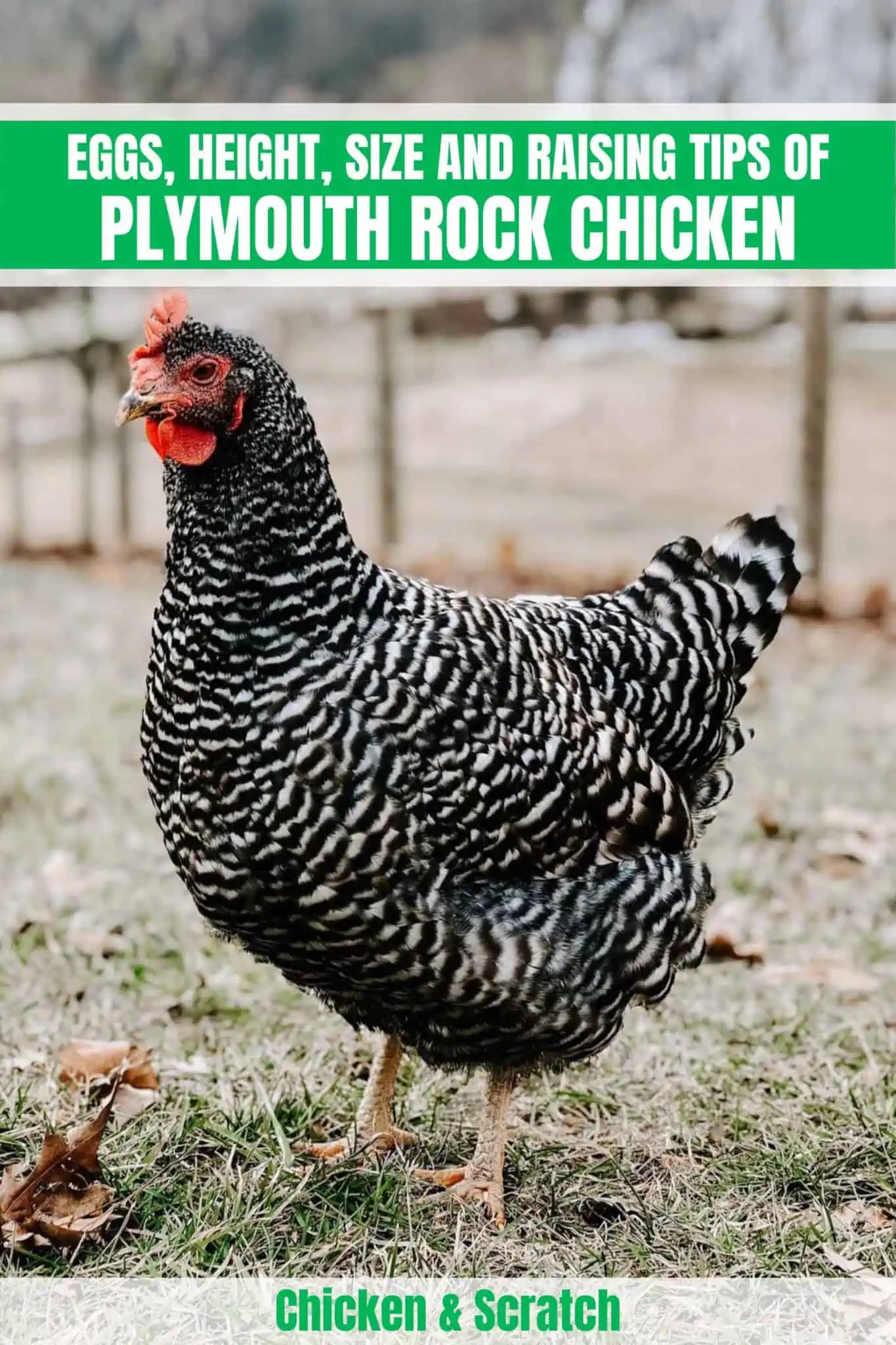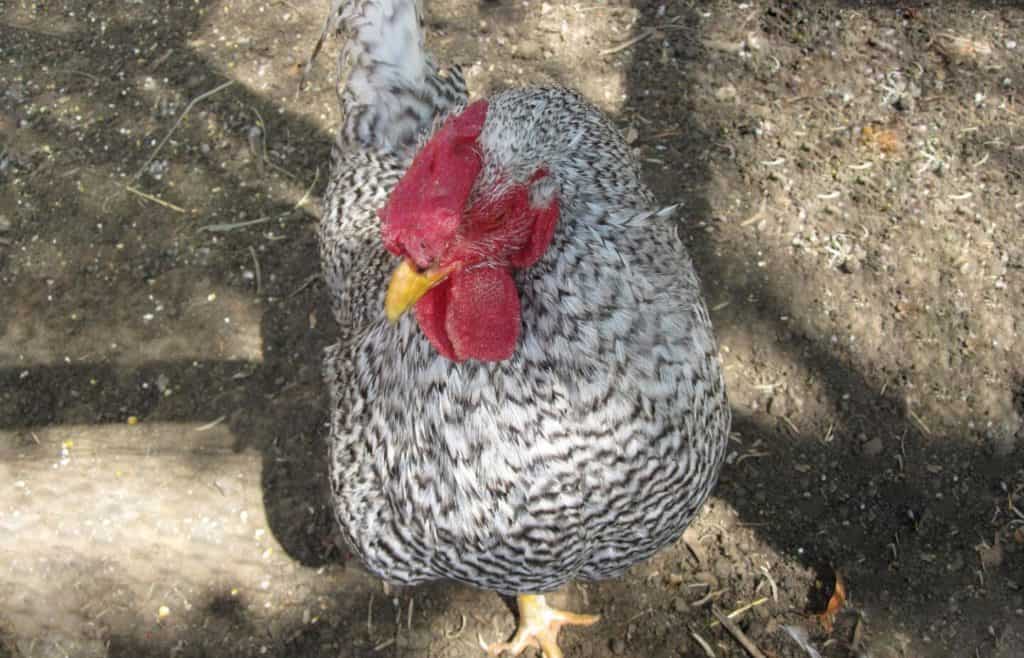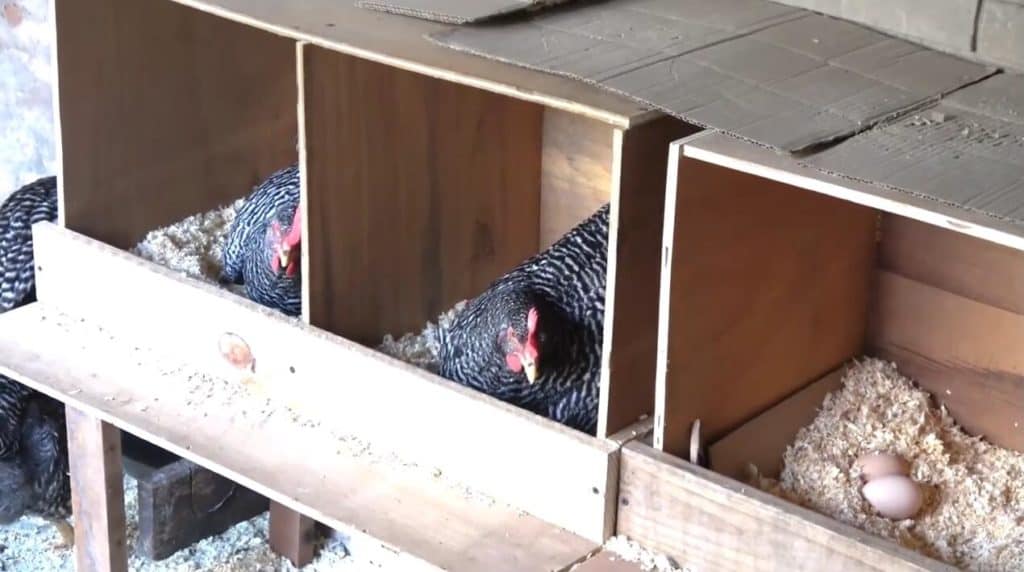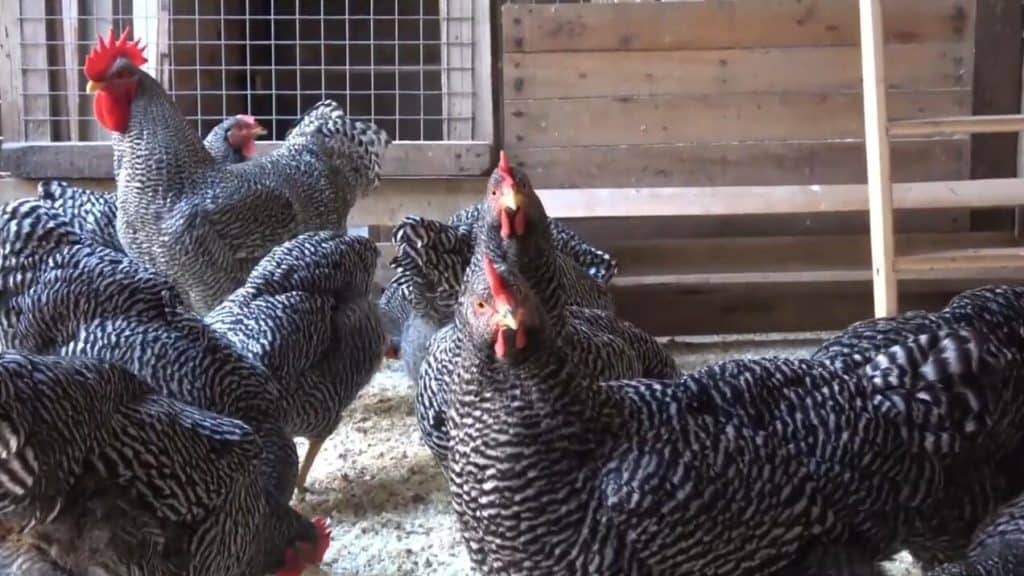Just as the name might imply, the Plymouth Rock chicken is one of the oldest poultry breeds in the United States. Prior to the industrialization and mechanization of the poultry industry, the Plymouth Rock chicken provided a significant amount of chicken meat and eggs to American families.

Plymouth Rock Chicken History
The Plymouth Rock chicken is first documented as present in Massachusetts around 1849. However, the breed virtually disappeared for about twenty years; the next mention of the breed was in 1869 when a Massachusetts native described breeding Java hens with roosters sporting a barred plumage pattern.
Most experts believe that this is the ancestor of the Plymouth Rock chicken of today. During World War II, the Plymouth Rock chicken was the most recognizable breed due to its task in providing the bulk of eggs and chicken meat across the country.
The only other chicken breed to be as prolific and as productive as the Plymouth Rock at feeding American citizens was the Rhode Island Red. The government even encouraged citizens to keep this particular breed as it was used to provide food sent to the troops overseas.
Although there are still those who keep Plymouth Rock chickens personally, the chicken farming industry has largely labeled Plymouth Rock as a breed that does not meet the production needs of today’s market. This opinion exists even in spite of the fact that Plymouth Rock chickens have superior egg production as well as one of the better varieties of chicken meat.
The Plymouth Rock chicken is also one of the most visibly recognizable birds as its barred pattern is one that is iconic in American culture. Speaking of egg production, the Plymouth Rock chicken has always proven as one of the top producers of brown eggs.
Plymouth Rock Chicken Overview
| Feature | Plymouth Rock Chicken |
|---|---|
| Purpose | Dual purpose (meat, egg) |
| Egg Color | Brown |
| Egg Size | Medium to Large |
| Broody | Occasionally |
| Heat Tolerance | Yes |
| Cold Tolerance | Yes |
| Comb Type | Single comb |
| Egg Production | ~200 eggs per year |
| Chicken Skin Color | variety of colors |
| Life Span | 8-10 years |
| Adult Weight (Hen) | ~7.5 lbs |
| Adult Weight (Rooster) | ~9.5 lbs |
| Backyard Friendly | 5/5 |
Plymouth Rock Chicken Appearance

As previously stated, Plymouth Rock is a breed of chicken that is highly recognizable. It’s black and white “barred” appearance is what most Americans recognize about the breed. Males often have a more equal black barring and white barring pattern to their plumage, but females have black “bar” plumage that appears to be larger than the white bar.
The female, as a result, tends to have more of a gray appearance than the eye-catching pattern of the male Plymouth Rock.
The body of the Plymouth Rock is large and triangular in shape; the chicken will have a full breast as well as a long, wide back. The skin and legs will be a “clean” yellow; their ear lobes, comb, and any wattles will be a bright red.
The beak is “horn-colored,” and the eyes are “reddish bay.” It is considered a breed standard for the single comb to contain no more or no less than five points.
There are, currently, seven accepted varieties of Plymouth Rock chickens: Barred, White, Blue, Partridge, Buff, Silver Penciled, and Columbian. The Barred and the White are the most common varieties; all others are considered rare.
Personality and Temperament
The personality and temperament of the Plymouth Rock is often correspondent to the coloring of the chicken. Barred Plymouth Rock chickens are said to be “mellow.” They seem to be happy-go-lucky as far as chickens go, and they tend to get along with other members of their flock.
They typically have a good attitude, and they generally do not pick fights with other chickens in their flock. Even the roosters are described as “docile.”The White Plymouth Rock or one of the rare varieties of the breed are also known for their tendency to be docile.
Overall, Plymouth Rock is known as a breed that tends to be a pleasure to own. They tend to have more human interaction than other chickens.
Owners state that they have a tendency to follow their handlers around, perhaps in search of a treat or a bit of extra food. Plymouth Rock is a naturally curious chicken, and they enjoy exploring their environment.
They do prefer to be free-range chickens; however, given ample room to move around, Plymouth Rocks tend to tolerate confinement fairly well. Plymouth Rock is a chicken that typically develops good relationships with its family, including the children.
Plymouth Rock Chicken Egg Laying

After the industrialization of the poultry industry, Plymouth Rock was dismissed due to the idea that it could not meet the production demands of the American consumer.
The typical laying hen produces between 260 and 300 eggs per year (the White Leghorn is the most popular hen for the job, and she will lay about 260 eggs; an “improved” chicken will lay upwards of 300).
The Plymouth Rock chicken typically lays four eggs per week and averages about 200 eggs per year. The Plymouth Rock produces brown eggs, which have a market niche all their own.
One reason Plymouth Rock lost its dependability as a producer of eggs has more to do with its total lifelong ability to produce eggs. The average Plymouth Rock hen does really well at production for the first couple of years of life, but, after year three, their production goes down each year until year ten.
Health Issues and Care

The Plymouth Rock was so popular not only for its production rate but also because the Rock is overall quite a healthy chick! Often, the most common ailment of the Plymouth Rock’s life deals with parasites, typically mites or lice.
However, the Plymouth Rock chicken may sometimes deal with intestinal parasites. Owners can simply incorporate apple cider vinegar as well as crushed garlic into the diet of Plymouth Rock in order to prevent these parasites.
Some ailments in Plymouth Rock that might affect them detrimentally as producers include Bumblefoot, Vent Gleet, and Vent Prolapse. Bumblefoot is a layman’s term for pododermatitis, which is a form of a Staph infection in chickens.
It typically starts in a chicken’s left foot, and is completely treatable should the issue be caught in time. Bumblefoot typically starts as an injury that has become infected with the Staphylococcus bacteria manifesting itself as a lesion. Again, this is a completely treatable condition. You can read our post: Bumblefoot in Chickens: What Causes & How to Treat?
The next ailment that Plymouth Rock chickens may experience is Vent Gleet. Vent Gleet is another word for Cloacitis, which is inflammation of the cloaca. Like Bumblefoot, Vent Gleet is highly treatable, but it must be caught in time.
Chronic, recurring incidences of Vent Gleet may cost your chicken its life. Vent Gleet is closest to the fungal infection thrush, and you’ll notice a bad odor around your chicken. Feeding your chicken apple cider vinegar often helps to prevent this condition.
Finally, Vent Prolapse is a health ailment some Plymouth Rock hens may experience. In a prolapse, part of the vent has fallen. Egg production will decrease, if not end altogether.
You’ll see tissue hanging from the vent area as a major sign of the issue. As with other ailments, you’ll want to treat this as quickly as possible to prevent further effects of the condition.
Tips for Raising Plymouth Rock Chickens

Although the Plymouth Rock chicken is one of the easiest to raise into a thriving bird, it will need the same amount of care as any other breed. Fortunately, Plymouth Rock does not have many requirements in the way of care. In fact, the Plymouth Rock is often a breed that is recommended for even the most inexperienced breeder.
The Plymouth Rock will not need any extra grooming needs, or at least it needs no more grooming than any other chicken. Be sure that the Plymouth Rock is parasite-free, and provide a place where the Plymouth Rock can groom itself by dust bathing.
Where diet is concerned, you’ll want to make sure your hens have extra calcium. Do this by either providing shell-grit or crushing eggshells and placing them in the food of the hens.
Remember to periodically add a small amount of apple cider vinegar to their food as well, this will prevent many of the ailments common to the breed. Otherwise, provide normal layer feed, and the Plymouth Rock chicken will peck at it when he or she needs nutrients.
Keep in mind that Plymouth Rock will need ample room to satisfy his curiosity regarding his surroundings. He will also need a safe chicken coop for nesting. The hens will need a private nesting box room. Provide a number of perches so the chicken can roost at night and sleep.
Make sure the coop is well-ventilated and built to be cool in the summer and warm during the winter. Plymouth Rocks also seem to do well in enclosed areas as long as they have plenty of room to run around otherwise.
Summary
Plymouth Rock is not only one of the oldest breeds of chicken in America, but it is also one of the most popular. It is a great “starter” breed for inexperienced chicken owners, and they have a high rate of health and production.
They do not require much care, and they actually enjoy fostering a relationship with the humans around them. Choose a Plymouth Rock chicken, and you’ll not regret owning this wonderful breed.


Joseph Hudson has been raising chickens for over 15 years. In 2018, he completed the Agriculture & Natural Resources program at Mt. San Antonio College. He currently raises over 1400 chickens on his 7.5-hectare farm. He keeps sharing his experience on raising healthy and happy chickens on Chicken Scratch The Foundry.








Very good explain. Thanx.
I need to know if they can handle high heat in desert environment.